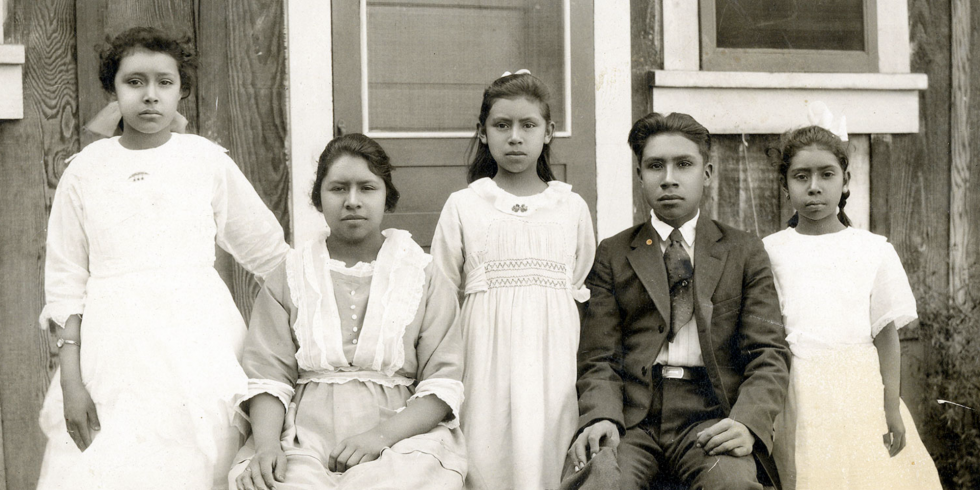Case 4 Orientation
You have opened the eleventh of thirteen QR codes located throughout the gallery.
The fourth section of ¡Presente! is “Shaping the Nation.” This case is located on the right side of the gallery. It examines stories about Latinos and Latinas as community builders who have shaped the United States. To the left of the case is a nook. Behind you is a Foro, or plaza, in the middle of the gallery.
Case 4 Themes
The “Shaping the Nation” case explores three main themes. On the left side of the case: Latinos and Latinas building community; in the middle of the case: Latinos and Latinas fighting for justice; on the right is Latinos and Latinas breaking boundaries.
Panel 1: Bulding Community:
Label Text and Object Descriptions
Latino communities have been built by local leaders.
Grandmothers, teachers, doctors, business owners, activists, artists, and many others have worked together to make a difference. The diverse stories of Cuban priest Félix Varela, the Black Dominican activist Carlos Cooks, and the League of United Latin American Citizens (LULAC) are all rooted in the needs of their communities.
For many Latinas and Latinos, the concept of community goes beyond ethnicity or nationality. It finds purpose in bringing people together to build a just society for all. The objects and stories here come from California, Florida, Illinois, New York, Texas, and Washington, D.C.
Object Group 1 Description:
California physician C. David Molina’s medical bag with two short handles and name “C.D. Molina” embossed on the surface in gold letters. Mouse and cockroach hand puppets dressed in fancy suit and dress, from Teatro SEA, a New York City community theater. A round, flat, wooden Yoruba divination tray with geometric engraving along the border and silver chain extended on it, made by Adrian Castro, a Cuban American Chinese medicine doctor.
Panel 2: Fighting for Justice:
Label Text and Object Descriptions
The history of Latinas and Latinos has been shaped by the struggle for justice.
At first these struggles involved specific Latino communities. In the 1800s, Mexican Americans fought early legal battles for their civil rights. Later, Latinas and Latinos began to mobilize in response to issues that affect multiple U.S. communities. Latino groups have fought for fair labor practices, education access, safe housing, immigration and criminal justice system reform, and LGBT rights, among other issues. Historically, many Latinas and Latinos have been disenfranchised. This led to a tradition of coalition building with diverse U.S. communities. Latinas and Latinos continue to work alongside others to make a more just and inclusive society.
Object Group 2 Description:
1960s bilingual political campaign buttons reading, “¡Viva Reagan!” and “Boycott Chiquita”. 1983 multicultural organization button reads, “National Rainbow Coalition.” Graphic reproduction of black and white photo of an unidentified man wearing a trench coat, tie, fedora hat. Man holds a protest sign reading, “Jim Crow Doesn’t Teach,” in Spanish. Photo shot by Puerto Rican photographer Frank Espada at a 1964 boycott against racial segregation in New York City schools.
Panel 3: Breaking Boundaries:
Label Text and Object Descriptions
Latina and Latino boundary breakers have shaped U.S. history. They set new standards for excellence, creativity, and civic participation.
They are activists, artists, athletes, military veterans, small business owners, and many others. Some, like Supreme Court Justice Sonya Sotomayor, have entered spaces where no Latina and Latino have been before. Many have left their creative mark on struggles for justice. They fought racial segregation in schools and demanded LGBT rights. Their distinct experiences defy any single representation of the U.S. Latino experience. The stories displayed here show how Latinas and Latinos have energized U.S. culture and democracy.
Object Group 3 Description:
Mexican American street skating pioneer Mark “Gonz” Gonzales’ scratched-up skateboard, with hand-painted drawings on its surface. Graphic reproduction of a photo of first Latina Supreme Court Justice, Sonia Sotomayor, shown in a three-quarter profile wearing a black suit jacket.
Signature Object: NASA Helmet:
Object Label Text and Description
In 1993, Mexican American research engineer Ellen Ochoa was the first Latina to go to space. There, she researched the earth’s ozone layer. Ochoa, who grew up in Mesa, California, wore this helmet while flying NASA T-38 jets during training.
Round, gray aviator helmet with the NASA logo adhered above the black face shield. A mask and hose on the helmet’s right side attach to the oxygen supply in the aircraft.
Directions to Next QR Code
QR code 12 is across the aisle on your right, on the side of the digital interactive table about 6 feet away. QR Code 13 is across the aisle on your left.
